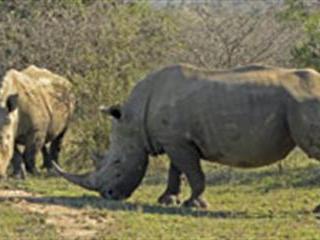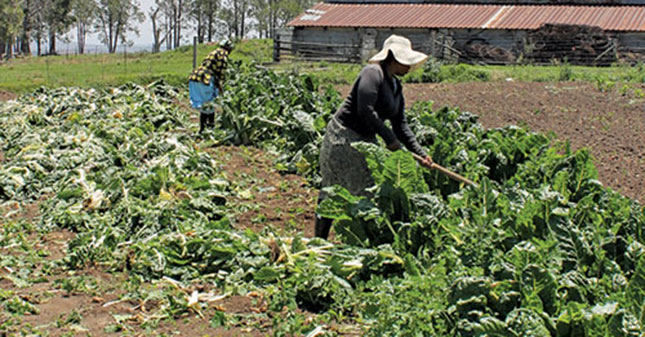
KZN experienced a decline in numbers of rhino poached between 2010 and 2011. What are the current rhino stats?
The rhino poaching tally in South Africa has rocketed over the past four years, from 122 rhino poached in 2009, 333 in 2010
to 448 in 2011. Indications are that this year’s figures will increase beyond last year’s. Since the start of the year, 331 rhino have been killed across SA. In KZN, 24 rhino had been killed by 18 June, compared to 34 in 2011 and 39 in 2010.
How many people have been arrested for rhino poaching this year?
There have been 178 arrests made. South Africa needs to take a united approach to win the war against rhino poaching. The public’s active involvement can lead to more arrests.
Are you satisfied that the courts are taking a tough enough stance against people involved in rhino poaching?
There are positive developments in this field, but there is room for improvement.
The private sector has seen a sharp increase in rhino killings. What is being done to protect these rhino?
Of the 24 rhino killed in KZN this year, 12 have been on privately owned land. The private sector has become a soft target. Ezemvelo has implemented an anti-rhino poaching strategy, increased its security and tightened operational loopholes. In 2011 we created a new unit, the KZN Rhino Project, to support private game farm owners. Headed by Ezemvelo KZN Wildlife rhino security co-ordinator, Jabulani Ngubane, the unit works with private game farms to reduce the number of poaching incidents. The unit is assisted with equipment, training and anti-poaching strategies to help it deal with the scourge of rhino poaching.
What is the budget for the rhino unit?
It was allocated R2,8 million in equipment and cash. We continuously look for funds as the programme relies on donor funding, such as that done via the ongoing SMS system with MTN. The final budget raised can only be determined at the end of the financial year.
How many additional personnel has Ezemvelo employed to deal with rhino poaching?
We recruited, trained and deployed 25 field rangers between 2008 and 2012, although we had previously recruited and deployed rangers.
How many rhino have been micro- chipped and had their DNA stored?
We have been micro- chipping our rhino for years but DNA sampling is a new protocol which started in 2009. We take DNA samples from all crime scenes, when translocating our rhino or at any opportunistic capture. Of all rhino in KZN, 70% have been micro-chipped and 15% have been DNA sampled.
Ezemvelo is in favour of legalising the rhino horn trade. When do you hope that will happen?
We do not have a set date but in March 2013 we will table a proposal to the Convention on the International Trade in Endangered Species (Cites) in Thailand, through the Department of Environmental Affairs (DEA). We have to try something different and trading rhino horn is a mechanism I am now prepared to support.
There have been reports that this bid might not get approval from the necessary government departments to make it to Cites in 2013. Is the 2013 Cites bid still achievable?
I don’t think it is wise to speculate, but the national portfolio committee for environmental affairs in Cape Town requested that we do the proposal. The minister of environmental affairs, Edna Molewa, will make an announcement in October 2012 regarding this issue.
How will controlled trade work?
Ezemvelo has drawn up a detailed draft proposal to advance the introduction of a Centralised Selling Organisation (CSO) to regulate the price of rhino horn. Such a mechanism would sell more than the current illegal supply of rhino horn, at a price that limits demand to sustainable or current levels. Speculative demand will decline, because the outlook will be for regular supplies of horn meeting market demand.
There would therefore be less scope for price appreciation. Such open market sales would be to accredited buyers only, such as pharmaceutical companies supplying the Far East. Legal horn would be defined as that emanating from natural mortalities; horn confiscated though court convictions and horn forming part of the existing substantial national stockpile. The horn would be micro-chipped, chemically analysed and certified.
What is Ezemvelo’s stockpile of rhino horn?
For security reasons I will only give the total for KZN as a province: 4 120 horns at a weight of 7 852kg, both privately and state-held.
How much is rhino horn currently selling for?
The illegal market price of rhino horn has reached above US$40 000/ kg or R330 000/kg.
Wouldn’t the price come down if SA dumped its registered stockpiles on the market?
I don’t believe we should dump rhino horn on the market. The Far Eastern demand is colossal and this would encourage speculators to hoard stocks to sell later at higher prices. It would by no means saturate the market. Traded on a regulated market, the present national stockpile of rhino horn would last for more than 10 years, with annual accruals. In that time, at current growth rates, the white rhino population will have doubled. The population could then sustain annual sales. Nevertheless, South Africa’s current position with regard to rhino is precarious.
Do you support rhino horn ‘farming’?
No. It is not aligned with our mandate and the Rhino Management Strategy of the organisation.
Earlier this year, Ezemvelo announced a helicopter surveillance pilot project, funded by Durban businessman Vincent Christoforous, which led to a decline in rhino poaching at its game reserves. Did the private sector respond to your appeal for funding to keep the project running?
Currently we have no corporate sponsor for the helicopter, so it is not running. We use our Bantam aircraft for patrols but this is a different operation.
Why didn’t Ezemvelo fund this helicopter initiative?
We have asked Treasury for the budget, which amounts to R27 million. Ezemvelo does not have sufficient budget to fund the helicopter.
What checks are in place to determine whether Ezemvelo staff are involved in poaching?
We vet our employees and have intelligence and informer networks. We have already fired four employees and arrested three.
Contact Cecilia Sampson on 033 845 1511.













